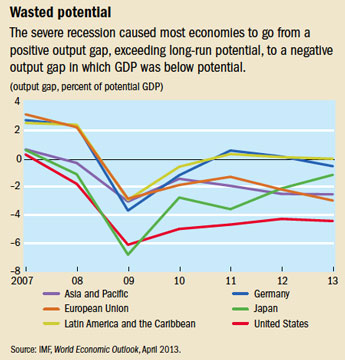Back to Basics
What Is the Output Gap?
Finance & Development, September 2013, Vol. 50, No. 3
Sarwat Jahan and Ahmed Saber Mahmud
Economists look for the difference between what an economy is producing and what it can produce
During economic downturns an economy’s output of goods and services declines. When times are good, by contrast, that output—usually measured as GDP—increases (see “Gross Domestic Product: An Economy’s All” in F&D's compilation of Back to Basics columns—www.imf.org/basics).
One thing that concerns economists and policymakers about these ups and downs (commonly called the business cycle) is how close current output is to an economy’s long-term potential output. That is, they are interested not only in whether GDP is going up or down, but also in whether it is above or below its potential.
The output gap is an economic measure of the difference between the actual output of an economy and its potential output. Potential output is the maximum amount of goods and services an economy can turn out when it is most efficient—that is, at full capacity. Often, potential output is referred to as the production capacity of the economy.
Just as GDP can rise or fall, the output gap can go in two directions: positive and negative. Neither is ideal. A positive output gap occurs when actual output is more than full-capacity output. This happens when demand is very high and, to meet that demand, factories and workers operate far above their most efficient capacity. A negative output gap occurs when actual output is less than what an economy could produce at full capacity. A negative gap means that there is spare capacity, or slack, in the economy due to weak demand.
An output gap suggests that an economy is running at an inefficient rate—either overworking or underworking its resources.

Inflation and unemployment
Policymakers often use potential output to gauge inflation and typically define it as the level of output consistent with no pressure for prices to rise or fall. In this context, the output gap is a summary indicator of the relative demand and supply components of economic activity. As such, the output gap measures the degree of inflation pressure in the economy and is an important link between the real side of the economy—which produces goods and services—and inflation. All else equal, if the output gap is positive over time, so that actual output is greater than potential output, prices will begin to rise in response to demand pressure in key markets. Similarly, if actual output falls below potential output over time, prices will begin to fall to reflect weak demand.
The unemployment gap is a concept closely related to the output gap. Both are central to the conduct of monetary and fiscal policies. The nonaccelerating inflation rate of unemployment (NAIRU) is the unemployment rate consistent with a constant rate of inflation (see “Unemployment: The Curse of Joblessness” in F&D's compilation of Back to Basics columns—www.imf.org/basics). Deviations of the unemployment rate from the NAIRU are associated with deviations of output from its potential level. Theoretically, if policymakers get the actual unemployment rate to equal the NAIRU, the economy will produce at its maximum level of output without straining resources—in other words, there will be no output gap and no inflation pressure.

The output gap can play a central role in policymaking. For many central banks, including the U.S. Federal Reserve, maintaining full employment is a policy goal. Full employment corresponds to an output gap of zero. Nearly all central banks seek to keep inflation under control, and the output gap is a key determinant of inflation pressure.
Because the output gap gauges when the economy may be overheating or underperforming, it has immediate implications for monetary policy (see “ Money: At the Center of Transactions” in F&D's compilation of Back to Basics columns—www.imf.org/basics).
Typically during a recession, actual economic output drops below its potential, which creates a negative output gap. That below-potential performance may spur a central bank to adopt a monetary policy designed to stimulate economic growth—by lowering interest rates, for example, to boost demand and prevent inflation from falling below the central bank’s inflation rate target.
In a boom, output rises above its potential level, resulting in a positive gap. In this case, the economy is often described as “overheating,” which generates upward pressure on inflation and may prompt the central bank to “cool” the economy by raising interest rates.
Governments can also use fiscal policy to close the output gap (see “ Fiscal Policy: Taking and Giving Away ” in F&D's compilation of Back to Basics columns—www.imf.org/basics). For example, fiscal policy that is expansionary—that raises aggregate demand by increasing government spending or lowering taxes—can be used to close a negative output gap. By contrast, when there is a positive output gap, contractionary or “tight” fiscal policy is adopted to reduce demand and combat inflation through lower spending and/or higher taxes.
Some policymakers have recently suggested that, in an increasingly integrated world economy, the global output gap can affect domestic inflation. In other words, all else equal, a booming world economy may increase the potential for inflation pressure within a country. For example, stronger global demand for computers raises the price U.S. producers can charge their foreign customers. But because all computer producers are facing a stronger global market, U.S. producers can charge more for their output at home as well. This is known as the “global output gap hypothesis” and calls for central bankers to pay close attention to developments in the growth potential of the rest of the world, not just domestic labor and capital capacity.
But there is so far no conclusive evidence to support the notion that a global output gap influences domestic prices. Still, the global output gap may become increasingly important if the world’s economies continue to integrate.
Hard to measure
Measuring the output gap is no easy task. Unlike actual output, the level of potential output and, hence, the output gap cannot be observed directly. Potential output and the output gap can only be estimated.
Various methodologies are used to estimate potential output, but they all assume that output can be divided into a trend and a cyclical component. The trend is interpreted as a measure of the economy’s potential output and the cycle as a measure of the output gap. The trick to estimating potential output, therefore, is to estimate trends—that is, to remove the cyclical changes.
A common method of measuring potential output is the application of statistical techniques that differentiate between the short-term ups and downs and the long-term trend. The Hodrick-Prescott filter is one popular technique for separating the short from the long term. Other methods estimate the production function, a mathematical equation that calculates output based on an economy’s inputs, such as labor and capital. Trends are estimated by removing the cyclical changes in the inputs.
Any estimate of potential output will have its shortcomings. Estimates are based on one or more statistical relationships and therefore contain an element of randomness. Moreover, estimating the trend in a series of data is especially difficult near the end of a sample. That means, of course, that the estimate is the most uncertain for the period of greatest interest: the recent past.
To circumvent these issues, some economists use surveys of producers to infer the extent of excess demand or supply in the economy. But surveys are also imperfect because firms may interpret questions differently, and there is no guarantee that responses will be indicative of demand pressure. Moreover, most surveys have a limited response base.
Regardless of the method used, estimating the output gap is subject to considerable uncertainty because the underlying relationships in the economy—that is, its structure—often change. For example, when the economy is emerging from a deep recession there may be much less spare capacity than anticipated because of such developments as
• unemployed workers who leave the labor market and become economically inactive;
• firms that close, leaving depressed areas and regions; and
• banks that lose money in a recession and become very strict with their lending.
Minding the gap
Because of the difficulties of estimating potential output and the output gap, policymakers need several other economic indicators to get an accurate reading of overall capacity pressure in the economy. Among those indicators are employment, capacity utilization, labor shortages, average hours worked and average hourly earnings, money and credit growth, and inflation relative to expectations.
These alternative measures of capacity can help policymakers enhance their measurement of the output gap. Even though it is difficult to estimate, the output gap has guided and will continue to guide policymakers. ■


